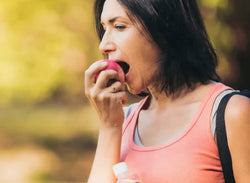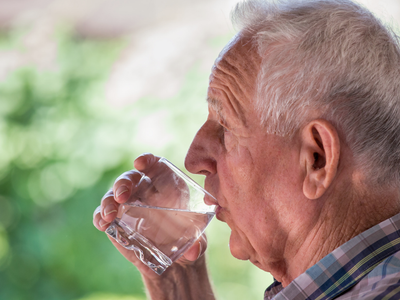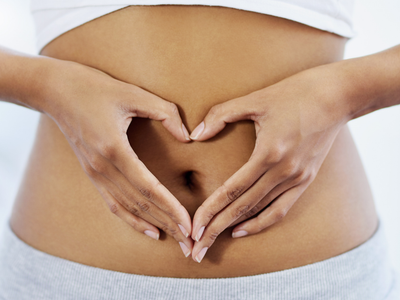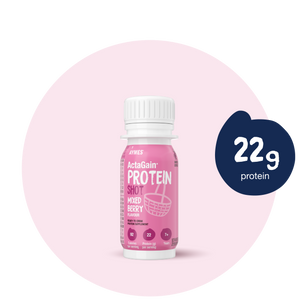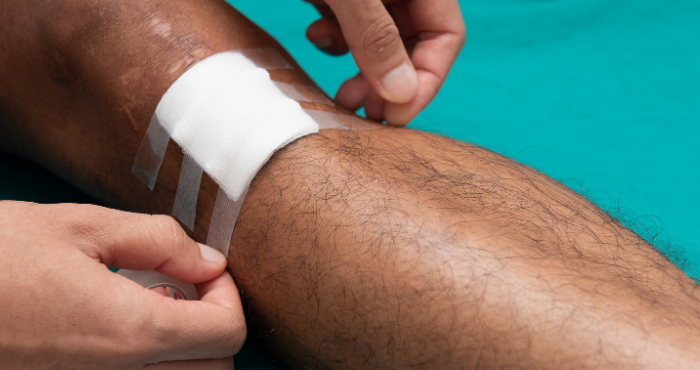
Many dietitian’s caseloads are likely to include patients with pressure ulcers, as nutritional intervention is a vital part of their management. However, there can be confusion when it comes to the prevention and treatment of pressure ulcers. Even down to the name; is it a pressure sore, injury or ulcer? In this blog, we ask dietitian Annina Whipp to bust some of the common myths surrounding nutrition and pressure ulcers.
Myth 1: Pressure sores, ulcers and injuries are different types of wounds
NHS Improvement (NHSI) revised the definition and measurement of pressure ulcers to support a more consistent approach across all trusts at both local and national levels.¹
The term ‘pressure ulcer’ is used to refer to a localised injury to the skin and/or underlying tissue, usually over a bony prominence, caused by pressure alone, or pressure in combination with shear (gravity force from a chair or bed pushing down on the patient's body).¹˒² The damage can be present as intact skin or an open ulcer and may be painful.¹ Pressure sore and injury are now considered outdated terminology.
Myth 2: Pressure ulcers are inevitable in malnourished and elderly patients
There are many risk factors for developing pressure ulcers, with mobility, incontinence, nutritional status and age being the most common.³ Patients with malnutrition or low body weight are at high risk of developing pressure ulcers due to a lack of natural padding on prominent bony sites such as the sacrum, hips, back and shoulders. At the other end of the spectrum, overweight patients are at risk of pressure ulcers due to a greater weight bearing load through pressure areas such as the sacrum.⁴˒⁵ Therefore, pressure ulcers are not exclusive to older or malnourished patients as sometimes expected.
Effective screening using validated tools (e.g., the Norton scale for pressure ulcers⁶ and the Malnutrition Universal Screening Tool for malnutrition⁷) alongside timely interventions, including nutrition support and regular repositioning, can help maintain tissue viability.³ With proactive care, pressure ulcers should not be inevitable in at-risk groups.
Myth 3: Nutrition isn’t important in the management and prevention of pressure sores
Insufficient energy, protein and fluid intake has been found to decrease the tolerance of skin to pressure, increasing the risk of breakdown.³ Poor nutritional status can impair wound healing and alter immunity, making the cycle of pressure ulcers difficult to break in malnourished patients.³
Optimising nutritional intake is important in the management of pressure ulcers and all patients with pressure ulcers should be referred for a dietetic assessment.⁸ Energy requirements for patients who have or are at risk of pressure ulcers and malnutrition are 30-35 kcal/kg body weight/day.⁹ Protein recommendations are 1.25-1.5 g/kg/day.⁹ Nutritional goals should be adjusted according to the patient’s clinical condition and weight change. Fluid intake should be tailored to the patient based on comorbidities, clinical goals and symptoms.⁹
In the presence of obesity, optimal nutritional intake should be encouraged as evidence has shown that restrictive diets low in energy and protein can compromise wound healing.⁹
With pressure ulcers, it is recommended that a multi-component treatment approach is taken.² This includes regular repositioning, wound dressing, nutrition support, analgesia and antimicrobial therapy.² Each aspect has a vital part to play in the healing and prevention of pressure ulcers.
Myth 4: All pressure ulcer patients can meet their protein requirements through diet alone
A food first approach is the preferred way to meet nutritional requirements.⁸˒¹⁰ This is achieved through a high-protein, high-energy diet consisting of regular meals, snacks, nourishing drinks and food fortification (e.g., the addition of full fat milk, olive oil, cream and cheese to meals). Patients with pressure ulcers have higher protein requirements. For example, a 70kg man with a pressure ulcer would need 87-105g of protein per day. Here’s an example of what that would look like:¹¹
Breakfast:
2 medium eggs on 2 pieces of toast with fresh tomatoes
Lunch:
100g tinned tuna with medium jacket potato and green salad
Evening meal:
90g beef mince with spaghetti and broccoli and peas
125g yoghurt
Snack:
250mls milk and a banana
It is clear from the above meal plan that achieving protein requirements via diet may be difficult for some patients, particularly those who are older or unwell as appetite is often limited. Guidelines advise that if patients with pressure ulcers are unable to meet nutritional requirements via diet, oral nutritional supplements (ONS) are indicated to increase energy and protein intake.⁸˒¹⁰
ONS are available in a range of styles and flavours. Low volume supplements (e.g., compact versions, or shot style supplements) and high protein ONS (≥ 20% energy from protein) are useful for helping patients with pressure ulcers to achieve energy and protein requirements.¹²˒¹³
Myth 5: Pressure ulcer patients only require a dietitian and tissue viability nurse
The prevention and treatment of pressure ulcers includes repositioning, wound dressing, incontinence management, nutrition support, analgesia and antimicrobial therapy, which span several specialities.³ This multi-modal approach demands the input of a multidisciplinary team (MDT) including a consultant/registrar, tissue viability nurse, nurse, healthcare assistant, dietitian, physiotherapist, pharmacist and occupational therapist. The collaborative working of an MDT emphasises the importance of treating the whole patient.
Useful Links
-
Stop the Pressure
A programme commissioned by NHS England and NHS Improvement for healthcare professionals. -
European Pressure Ulcer Advisory Panel
Supports all European countries in the efforts to prevent and treat pressure ulcers. -
React to Red Skin
A campaign to help carers identify and prevent pressure ulcers in the community. -
National Pressure Injury Advisory Pannel
The international clinical practice guideline for the prevention and treatment of pressure ulcers. - NICE Guideline 179: Pressure ulcers: prevention and management
- ◄References:
-
- NHS Improvement. Pressure ulcers: revised definition and measurement. Summary and recommendations. 2018. Accessed online: www.whittington.nhs.uk (Aug 2021).
- National Pressure injury Advisory Panel (NPIAP) [Internet]. Pressure injury Stages [2016; cited 2022 Apr 21]. Available from https://cdn.ymaws.com/npiap.com/resource/resmgr/online_store/npiap_pressure_injury_stages.pdf (Aug,21)
- British Medical Journal (BMJ). BMJ Best practice; pressure ulcer. 2021. Accessed online: https://bestpractice.bmj.com/topics/en-gb/378 (Aug 2021)
- Langer G, Fink A. Nutritional interventions for preventing and treating pressure ulcers. Cochrane Database Systematic Reviews. 2014. (6):CD003216. doi: 10.1002/14651858.CD003216.pub2.
- British Dietetic Association. Pressure ulcers (pressure sores) and diet: Food Fact Sheet. 2021. Accessed online: https://www.bda.uk.com/resource/pressure-ulcers-pressure-sores-diet.html (Aug 2021).
- Norton D, McLaren R, Exton-Smith. An investigation of geriatric nursing problems in hospital. 1962. London: National Corporation for the Care of Old People.
- British Association of Parenteral and Enteral Nutrition (BAPEN). Malnutrition Universal Screening Tool (MUST). 2016. Accessed online: http://www.bapen.org.uk/pdfs/must/must_full.pdf (Aug, 2021)
- National Institute of Health and Care Excellence (NICE). Pressure ulcers: prevention and management: Clinical guideline. 2014. Accessed online: https://www.nice.org.uk/guidance/cg179/chapter/1-Recommendations#management-adults (Aug 2021).
- Practice-based Evidence in Nutrition [PEN]. Wound Care and Pressure Injuries-Summary of Recommendations and Evidence. 2018. Accessed online: https://www.pennutrition.com/KnowledgePathway.aspx?kpid=7871&trcatid=42&trid=7859#3.2 (Aug 2021).
- National Institute of Health and Care Excellence (NICE). Nutrition Support for Adults Oral Nutrition Support, Enteral Tube Feeding and Parenteral Nutrition: Clinical guideline. 2017. Accessed online: https://www.nice.org.uk/guidance/cg32/resources/nutrition-support-for-adults-oral-nutrition-support-enteral-tube-feeding-and-parenteral-nutrition-pdf-975383198917 (Aug 2021).
- McCance R, Widdowson E, Institute of Food Research, Public Health England, Royal Society of Chemistry. McCance and Widdowson's the composition of foods. 2015.
- BNF: British National Formulary. Nutritional Supplements. 2020. Accessed online: https://bnf.nice.org.uk/borderline-substance-taxonomy/nutritional-supplements-non-disease-specific.html (Aug 2021).
- European Commission. Nutrition Claims. Accessed online: https://ec.europa.eu/food/safety/labelling-and-nutrition/nutrition-and-health-claims/nutrition-claims_en (Aug 2021).











